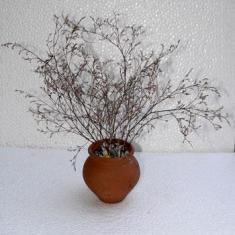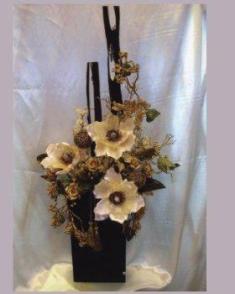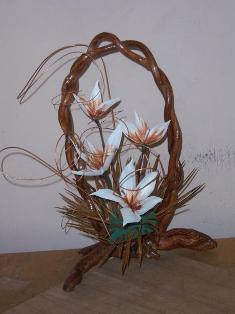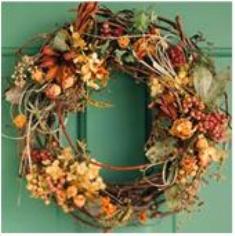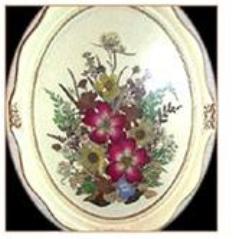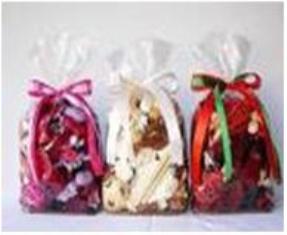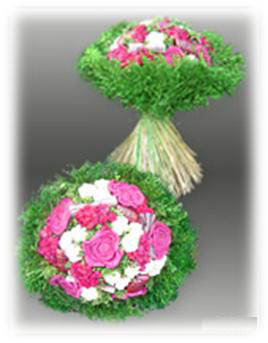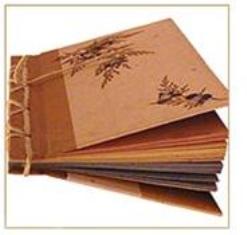DRY FLOWER TECHNOLOGY
Indian Dry Flower Market :
The most promising area in floriculture is the dry flower industry. Dried flowers and plants have been exported for the last 40 years and today, India is one of the leading countries in the field. Export of dried flowers and plants from India is more than Rs 150 crores per year. The industry exports 500 varieties of flowers to 20 countries and dry flowers are highly in demand in USA and UK markets. The potpourri variety of dried flowers is a purely export oriented and has specialized processing units. India, with its vast resources, varied products and experience in the field of dried flowers and plants enjoy a distinct advantage. Tamil Nadu is the leader in dry flower industry.
Dried flower products are in very high demand and add an enriched value to the flourishing industry. Various types of dry flower products are handmade paper, lampshades, wall quilt, decorations, books, candle holders, etc. The flower arrangements using dried samples of cone, foliage, flowers like rose buds, lilies and other such plant material enhances the beauty of dry flowers, adding more export value to this industry.
Harvesting flowers :
Flowers and other plant materials for drying should be picked close to their prime. Flowers or leaves for drying may be collected at any time during the growing season. The best time of day to cut is midmorning, after the dew has dried but well before any flowers wilt. Dampness can lead to mould and slows drying. During rainy weather, plants should be harvested when they are dry even if it means cutting them a little early. Damp or over matured plants should not be harvested. If harvesting flowers when wet is unavoidable, the excess moisture should be gently blotted off with a soft paper towel or tissue. Only the most perfect forms should be used. Poor shapes dry as poor shapes. Plants and flowers free of damage due to pest and disease incidence should be selected. This is because any such damage becomes only more obvious after drying. It is sometimes difficult to develop graceful lines when making dried flower arrangements. Therefore, while collecting material for dry flowers, branches and stems with sweeping curves or lines that will add distinctiveness to the arrangement should be selected. If none can be found, curves or other lines can be made by shaping the branches or stems into the desired positions while they dry.
Natural stems do not give the flower enough support when dry and may be difficult to manipulate and position. So, most of the stem is cut, leaving only about an inch. Stems can be replaced with florist's wire after drying. Flowers should be wired before drying them because drying may cause shattering in some cases.
Harvesting foliage :
Harvesting foliage in their active phase is preferable because at this stage, the leaves will be at peak maturity. Foliage is dried by preserving in a solution of water and glycerin. However, certain important points have to be borne in mind while harvesting foliage for preserving with glycerin. Young green leaves and leaves in dormant stage should not be harvested because young green leaves will not absorb the glycerin solution and the leaves in dormant stage would have stopped drinking water. So, both are unsuitable for absorbing glycerin.
Pre Drying Flowers :
Flowers that dry well are typically colorful, compact, strong-stemmed and relatively low in moisture content. Before the flowers are put into the drying process there are several measures to be taken for successful drying of the flowers.
a) Cleaning - After the plants are harvested or gathered, they must be cleaned. Cleaning may involve screening, washing, peeling, or stripping leaves from stems. Any unnecessary parts are removed prior to drying to avoid wasting time and energy. Cleaning is often done by hand.
b) Stem Supports -Many flower heads are too heavy for the dried stems to support during the drying process. The stems have to be cut and wired before hanging them out to dry. The wired stems have to be covered with floral tape after the flowers are dry. Some flowers can be wired after they are dried, but it is easier to wire them when they are fresh, because the wire slips through the moist heads more easily. Several stems of one type of flower or seed pod are wired together for a denser, brightly colored effect. If a flower head falls off during the drying process, a floral stem wire should be hot glued to the head or calyx of the dried flower, and the wired stem covered with florist tape.
c) Adding Wire Stems - Each flower head from the spray has to be cut so that the stem is approximately 1-1/2" long. Using 20-gauge wire, the wire should be cut to the desired length, allowing extra for bending and for the part of the stem to be inserted into the floral foam. The tip of the wire with pliers has to be bent to form a 'shepherd's hook'. The wire should be hooked around the calyx, where the flower head joins the stem, and squeezed tightly with needle nose pliers.
Drying Techniques :
Various methods are employed to dry flowers and foliage. The method adopted for drying depends largely on the character of the plant, that is to say whether the plant is glabrous, succulent or not succulent, hardy or delicate in nature.
a) Air drying - Air drying flowers is one of the easiest methods of preservation and gives plants a crisp look that lasts for years. Air drying flowers make a fabulous decoration by themselves, but when they are dry, they make more beautiful and exotic flower arrangements. This is commonly referred to as the “hang and dry” method. It is the oldest and easiest drying technique. No special equipment is needed. The stems of flowers and their foliage are tied and hung upside down. The rooms should be warm, dark and dry with good air circulation. However, it is one of the longest drying methods. It usually takes three to four weeks for the flowers to dry completely. The flowers are hanged upside down so that the stem remains straight. If they are hanged with right side up, they would bend over and the result will be dried flowers with distorted stems.
The ideal place for hanging the flowers is a place with ideal conditions like:
- Darkness
- Very good airflow
- Perfect humidity levels
Flowers are then sprayed with hair spray or clear varnish to retain their form. Air dried products tend to loose their original colour faster.
b) Water drying - Water drying is a method of preserving in which the leaves are stripped off and the flower stems placed in five centimeters of water. This is then, placed in a warm place, out of direct sunlight. The water is absorbed and evaporates as the flower dries. Hydrangeas, heathers, hybrid delphiniums, acacia, gypsophila, bells of Ireland, proteas and yarrow dry well this way. The best way to dry hydrangea flowers is by water drying.
c) Press drying:
One of the most popular methods for drying flowers is to put them under pressure, to remove the moisture out while leaving the color of the flowers and structure intact. There are several ways to apply pressure to flowers. The easiest method is placing them in heavy books and allow for drying. Flower presses can also be used. Unglazed paper, such as newsprint or an old telephone book, is best for pressing. Pressed flowers are especially suitable for flower pictures, as well as decoration on note paper, place cards and many other items.
d) Drying by embedding in dessicants :
A desiccant is simply a substance with a high affinity for water which can be used as a drying agent. Embedding the flowers in a granular, desiccating material is probably the most commonly used method and many consider it the best all around method. Several materials are used as drying agents. All the agents used vary in cost and in the results they produce. It is important to use the correct procedure when covering the flowers so that their form is maintained. Most well known is silica gel and borax but clean dry sand can also be used. Usually an airtight container is used; the flower heads are placed in the drying mixture face up, and very carefully covered with the mixture. The container must be kept closed during the drying process. After 4-14 days, depending on the thickness of the flower, the flower will be dry.
e) Glycerin drying-In this method moisture in a flower or foliage is replaced with glycerin and water. The flower is preserved and not dried. Dried materials (whole bunches or single leaves) retain their natural shape and flexibility. They last indefinitely and can be dusted or even wiped with a damp cloth without risk owing to the leathery texture of leaves. Glycerin drying involves the following process. The bark of the stem is removed and the cut end is smashed using a hammer. This portion of the stem is immersed in the glycerin and water solution. The leaf turns brown with glossy appearance after a month. Many types of foliage can be successfully preserved to maintain softness and flexibility. This is done by immersing leaves or placing stems in a 33 per cent glycerol solution.
f) Microwave oven Drying- Microwave drying is quick and relatively simple. It takes only a few minutes and provides dried flowers that look fresher and more colorful than obtained by other methods. Flowers with thick petals like magnolia are not suitable for drying in microwave. Since flowers vary in moisture content, texture and density, care should be taken to use the same sized flowers from one species at a time. It has been found that many flowers held almost true to life color and form using this process. Brightly colored flowers are best to dry. Flowers such as lilies, roses, violets, zinnias, and dahlias work well with this process.
Precautions for Microwave oven Drying:
- Start with a low setting
- Set the oven for a few seconds at a time.
- Different settings will produce different colour variations.
- Microwave friendly container should be always used.
- Wired flowers should not be used in a microwave oven
|
|
g) Freeze drying – Freeze drying (technically known as “lyophilization”) is the process of lowering the temperature of an object and then using a vacuum to extract all the moisture from the item. It is a state-of-the-art technique and the most effective method for flower preservation today. It is an innovative vacuum process that takes approximately four weeks depending on the flower. Freeze dried flowers go through a process in which water is removed as vapor directly from ice, without passing through the liquid state. This process is called sublimation, and requires reduced pressure to occur. All other drying methods use evaporation. In other words, water is removed as vapor from liquid water with heated air. The freeze drying machine drops the temperature to a -20 degrees F then it slowly returns the freeze dried flowers to room temperature over a four week period. This slow preservation process allows the freeze dried flowers to retain their original form, while the colors become enriched.
Bleaching and Dyeing- The major drawback of dried arrangements and other dry flower products is that they are dull and lack the brightness of fresh flowers. To overcome this problem, flowers are bleached and dyed. This enhances the visual appeal of the product.Bleaching is essentially whitening or decolourizing. It is an important step in the processing of dry plants.This chemical action removes the discolouration occurring during the dehydration phase of preservation of plants. It allows the effective use of dyes for colouring. Various chemicals like sodium hypochlorite, hydrogen peroxide and sodium chlorite to be the most commonly used bleach for plant foliage. Both chemical and natural dyes can be used. Enamel paints, interior paints, poster paints and tube paints could be employed for this purpose.
Skeleton Leaves :
Skeleton leaves are semi-transparent leaves, also called fossil leaves. They are prepared by soaking the fresh leaves in bleached water and then by hand rubbing the soft green flesh from the network of veins. The leaves can be then dyed to variant colors to give them a beautiful and pleasing appearance. Although delicate by nature, they are actually sturdy and can easily be glued to a variety of surfaces. They come in several colors and sizes to meet a complete line of crafting needs. The delicate beauty of these leaves is sometimes meant to capture life, hope and memories. These delicate, gorgeous skeleton leaves are a perfect accent for all craft projects. They make a beautiful and elegant statement when they adorn your wedding invitations. They work surprisingly well on gift tags, greeting cards, scrapbooks, collages, papermaking, stenciling, and stamping. They are perfect for decorating bridal bouquet, wedding reception table, candles, and wedding favors.
DryFlower Products :
Potpourri
Potpourri is a mixture of dried, sweet-scented plant parts including flowers, leaves, seeds, stems and roots. The basis of the potpourri is the aromatic oils found within the plant. These oils are not confined to the flowers but they are at their peak at flowering time. So they should be harvested just as the plant begins to flower. A properly blended potpourri will last for months. Its uses are unlimited. Pot pourri are used to perfume the air with their continual fragrances, scent drawers and closets, make sweet smelling stationery, add a final touch to room decorations with attractive baskets or create personal gifts to share with friends. Apart from being widely used for fragrance and beauty, potpourris are also used to repel moths and protect woollen garments in storage.
Driftwood
Driftwood is technically a wood that has been washed onto a shore or beach of a sea or river by the action of winds, tides, waves or man. It is a form of marine debris or tide wrack. However, any piece of wood can be used as driftwood depending on the imagination of the dry flower specialist. These pieces are submerged in water for around ten days and then dried, sand papered and varnished. Depending on the appearance and the individuals perception they can be used either as flower vases, legs for tables, decorative curios etc.
Conclusion :
There are many reasons for drying plant materials and one of them is the abundance of available materials. It is estimated that about 80% of flower species can be dried and preserved successfully. Sophisticated training and expensive equipment are not needed to come up with variety of designs. Unlike fresh flowers that easily lose their marketable value and quality, dried ornamentals offer longer periods of sale if properly preserved, packaged, and handled. Another unique characteristic of dried ornamental is their versatility. They can be arranged into different crafts according to one's preferred style, design, and use. The dry flower industry is waiting to be explored and needs to be popularized.
Source :
Dr.Preethi,
Horticulture College and Research Institute,
Periyakulam. | |

